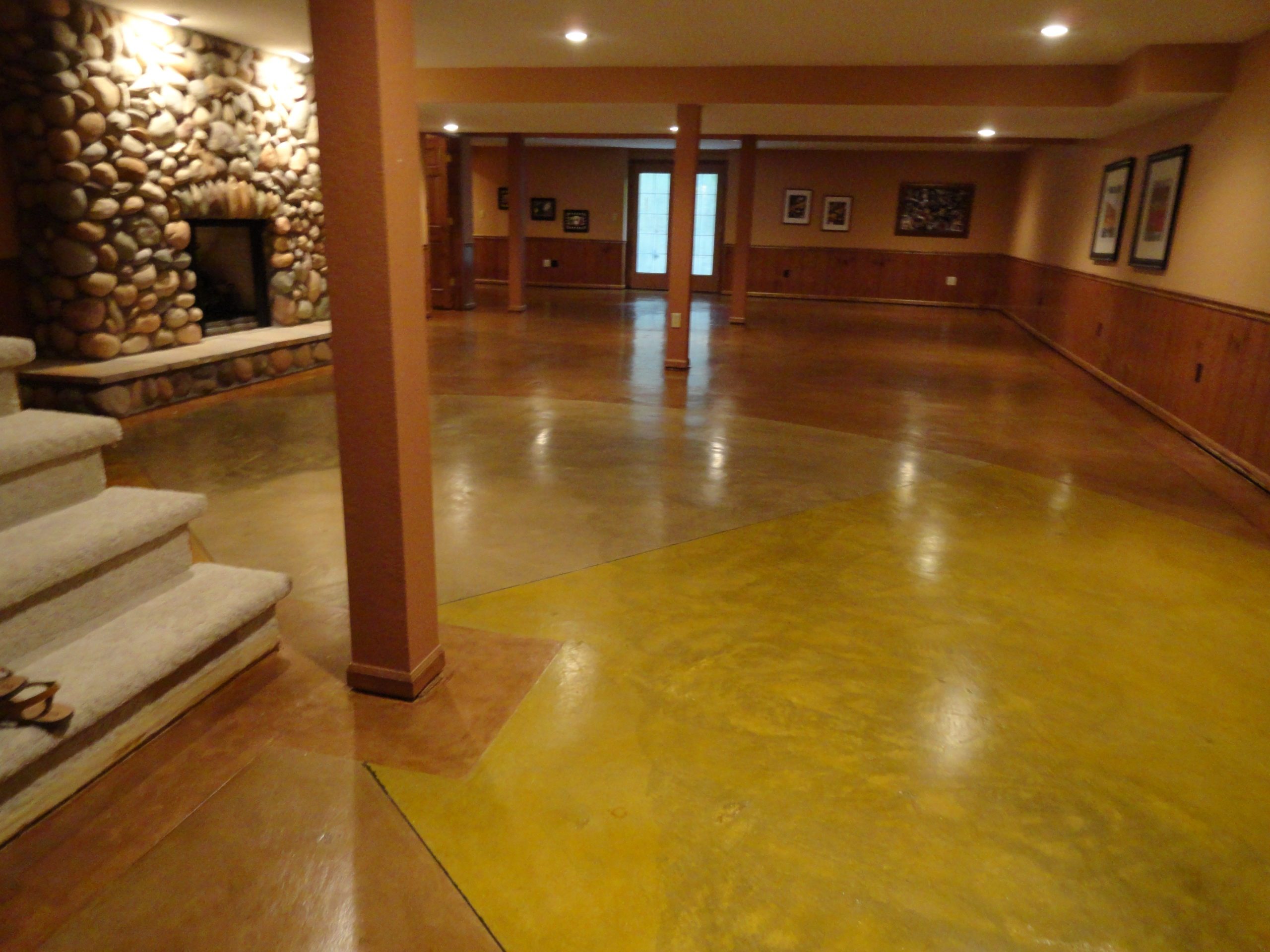Why designers in Austin love stained concrete austin
Recognizing the Various Kinds of Stained Concrete for Your Following Job
Stained concrete deals various alternatives that accommodate various aesthetic and functional needs. Each type provides distinctive characteristics that influence the last appearance and sturdiness of the surface. Recognizing these differences is vital for any person planning a task. From abundant, chain reactions of acid-based stains to the dynamic harmony of strong color stains, the selections can substantially influence the end result. What elements should one take into consideration when choosing the ideal stain for their particular needs?
Introduction of Stained Concrete
Stained concrete offers as a versatile flooring alternative that can boost the aesthetic allure of various rooms. This strategy involves using a coloring agent to the surface of existing concrete, enabling a wide spectrum of layout opportunities. Stained concrete is preferred in both household and commercial environments, using a durable and low-maintenance remedy that can mimic the look of all-natural products like stone or floor tile.
The discoloration procedure can be performed utilizing water-based or solvent-based products, each offering distinct visual effects. The last look is affected by elements such as the original concrete surface, the sort of tarnish utilized, and the application approach. Stained concrete not only beautifies interiors and exteriors but likewise advertises sustainability by renewing existing concrete structures. Because of this, it has actually obtained grip among homeowners and designers seeking both performance and design in their floor covering selections.
Acid-Based Stains: Qualities and Advantages

Unique Shade Variants
Concrete surface areas can change substantially with the application of acid-based stains, which offer an abundant palette of unique shade variants. These stains permeate the concrete, reacting chemically to create lively earth tones that vary from deep browns and reds to soft eco-friendlies and blues. The resulting hues are commonly variegated, creating a natural, marble-like appearance that boosts the concrete's personality. Each application yields unique results due to variants in the concrete's make-up and the discoloration technique utilized, making every job distinct. In addition, acid-based stains can be split or integrated with various other strategies to develop customized designs, enabling for individual expression. This flexibility makes acid-based stains a popular selection for both household and industrial applications.
Chain Reaction Described
While many variables add to the performance of acid-based stains, the underlying chemical responses play a vital duty in their special features and benefits. These stains largely include water, acid, and metallic salts. When related to concrete, the acid responds with the calcium hydroxide in the concrete, creating a chemical improvement that causes permanent shade adjustments. The metal salts permeate the surface area and bond with the concrete, permitting a variety of shades and tones. This reaction not just improves visual allure but likewise provides toughness, making the color resistant to fading and wear. Furthermore, acid-based stains can create a variegated coating that imitates natural rock, further enhancing their popularity for ornamental concrete applications.
Surface Area Prep Work Importance
Achieving perfect results with acid-based stains hinges on extensive surface area prep work. This important action assurances that the concrete surface is clean, cost-free of contaminants, and effectively profiled for suitable discolor absorption. Any type of existing sealers, dust, or oils can hinder the chain reaction that generates the preferred color and finish, bring about uneven or irregular results.
Prior to using the stain, the concrete needs to be mechanically cleaned up or pressure cleaned, complied with by a complete assessment for cracks or blemishes that might need fixing. In addition, confirming the surface is properly dried will certainly improve tarnish adherence. By focusing on these preparatory procedures, the long life and vibrancy of acid-based stains can be greatly boosted, causing a much more visually pleasing and durable coating.
Water-Based Stains: Features and Benefits

Water-based stains permeate the concrete, providing a more transparent coating that highlights the natural structure and variations of the surface area beneath. They are readily available in a vast array of colors, permitting for innovative adaptability in design. Additionally, water-based stains are less complicated to cleanse up, calling for just water and soap, which simplifies the application process.
Their quick drying time improves performance, making them a useful selection for both do it yourself lovers and experts. In general, water-based stains offer an enticing mix of visual adaptability and user-friendly buildings, making them a popular alternative for concrete enhancement projects.
Solid Color Stains: Vivid Options for a Vibrant Appearance
Solid shade stains provide an efficient remedy for those seeking to create a bold and vibrant aesthetic on concrete surfaces. These stains supply an uniform coloration that can significantly improve the aesthetic appeal of floorings, patio areas, and driveways. Available in a wide spectrum of shades, strong shade stains enable creative expression, satisfying numerous style choices.
One of the vital benefits of strong color stains is their capacity to hide flaws, providing a fresh and refined aim to aging concrete - Austin Stained Concrete Floors. Furthermore, their solution commonly includes UV-resistant properties, making certain durability and color retention even in extreme climate condition
Application is simple, needing minimal prep work of the concrete surface area. As soon as used, solid color stains can be secured for added protection and sheen, more boosting their aesthetic top quality. With their vivid alternatives, strong shade stains are an excellent selection for those going for an impactful and cohesive style.
Semi-Transparent Stains: Attaining Deepness and Measurement
Semi-transparent stains provide an unique strategy to boosting concrete surfaces by giving depth and dimension via various color choices. Comprehending the application strategies is necessary for attaining the desired effect, while correct maintenance methods guarantee durability. This area will explore these vital aspects to make the most of the benefits of semi-transparent staining.
Color Options Available
A variety of color options exists for semi-transparent stains, permitting house owners and developers to improve the natural appeal of concrete surface areas. These stains can be found in a range of shades, from natural tones like browns and terracottas to dynamic colors such as blues and greens. The semi-transparent nature of these stains allows the underlying concrete to reveal via, creating an unique deepness and measurement that can match various layout aesthetic appeals. Additionally, combining various colors can create custom shades, allowing a customized search for each task. This flexibility makes semi-transparent stains a prominent choice for both indoor and exterior applications, as they can harmonize with surrounding components while including aesthetic rate of interest to plain concrete.
Application Techniques Explained
To accomplish the wanted depth and measurement with semi-transparent stains, appropriate application methods are necessary. Surface prep work is vital; the concrete should be tidy and free of any type of contaminants. This typically involves power cleaning and repairing any try here fractures. Next, selecting the ideal applicator, such as a this link sprayer, roller, or brush, can affect the last look. Sprayers enable a much more also application, while rollers can help attain appearance. It is very important to apply the discolor in thin, even coats, permitting each layer to dry before adding an additional. Manipulating the application strategy, such as varying pressure or utilizing different devices, can create distinct effects. Ultimately, sealing the stained surface boosts the vibrancy of the colors while giving security.
Maintenance Ideal Practices
Routine upkeep is crucial for protecting the elegance and integrity of surfaces treated with semi-transparent stains. To keep these surface areas, regular cleaning is essential. Using a pH-neutral cleaner and a soft-bristle mop will aid eliminate dirt and debris without damaging the tarnish. It is advisable to prevent rough chemicals, as they can break down the tarnish's appearance. Additionally, periodic resealing each to three years can secure against wear and fading. This process entails cleaning up the surface thoroughly and using a suitable sealer designed for stained concrete. Home owners ought to additionally check for any signs of discoloration or damage and address these issues immediately to guarantee durable vibrancy and longevity. Following these ideal methods will boost the general lifespan of semi-transparent stained surfaces.
Effects and Methods: Tailoring Your Stained Concrete
Customizing stained concrete entails a variety of methods that boost both appearances and performance. Among these approaches, layering different discolor shades can produce depth and complexity, permitting special visual impacts. Strategies such as acid staining provide a variegated appearance, while water-based stains supply an extra consistent look.
Additionally, integrating attractive patterns, such as stenciling or inscription, can further personalize the surface, including intricate designs that accommodate specific preferences. Texturing the concrete, whether via marking or mop finishes, introduces responsive elements that not just boost grasp but additionally improve aesthetic interest.
Applying sealers can intensify the shade vibrancy and supply protection versus wear. Personalization techniques expand beyond simple shade; they can transform a common concrete piece right into a stunning prime focus, making it appropriate for both household and commercial rooms. With mindful option of impacts and methods, stained concrete can attain a really tailored appearance.
Upkeep and Durability of Stained Surfaces
Although stained concrete surface areas are understood for their sturdiness and visual charm, maintaining their integrity is vital for making certain durability. Routine cleansing is essential; sweeping and mopping with a pH-neutral cleaner assists protect against dust accumulation and discoloration. In addition, applying a sealer every few years can secure the surface from wetness, chemicals, and UV damage, thus improving its lifespan.
It is additionally crucial to address any type of cracks or chips quickly. Little repairs can alleviate more damage, preserving the aesthetic and architectural quality of the surface. For outdoor stained concrete, seasonal upkeep, such as eliminating snow and ice, is needed to protect against surface damages from freeze-thaw cycles.
Often Asked Concerns
Can I Stain Existing Concrete Surfaces or New Ones?
The question of whether existing concrete surface areas can Visit This Link be stained develops regularly. It is without a doubt feasible to discolor both brand-new and old concrete, offered the surface area is adequately prepared and devoid of contaminants for excellent bond.
For how long Does the Discoloration Process Typically Take?
The staining process typically takes one to three days, depending upon variables such as surface area prep work, type of tarnish, and climate condition. Stained Concrete Floors Austin Texas. Curing time may expand beyond first application, affecting the total duration significantly
Is Stained Concrete Safe for Outdoor Usage?
Stained concrete is generally risk-free for exterior usage, supplied it is appropriately sealed. This sealing protects versus dampness and UV damage, making certain sturdiness and safety and security, while additionally enhancing the visual allure of outdoor spaces.
Can I Use Numerous Discoloration Layers for Various Results?
Using multiple stain layers can achieve diverse impacts on stained concrete. It is essential to assure compatibility between stains and permit proper drying out time in between applications to avoid unintentional reactions or staining.
Are There Any Kind Of Color Limitations for Stained Concrete?
Color constraints for stained concrete primarily depend on the kind of tarnish utilized, with water-based stains providing a wider combination contrasted to acid-based stains. Stained Concrete Austin. Nevertheless, accomplishing vibrant shades may require mindful selection and application methods